
cover-agent
CodiumAI Cover-Agent: An AI-Powered Tool for Automated Test Generation and Code Coverage Enhancement! 💻🤖🧪🐞
Stars: 4223
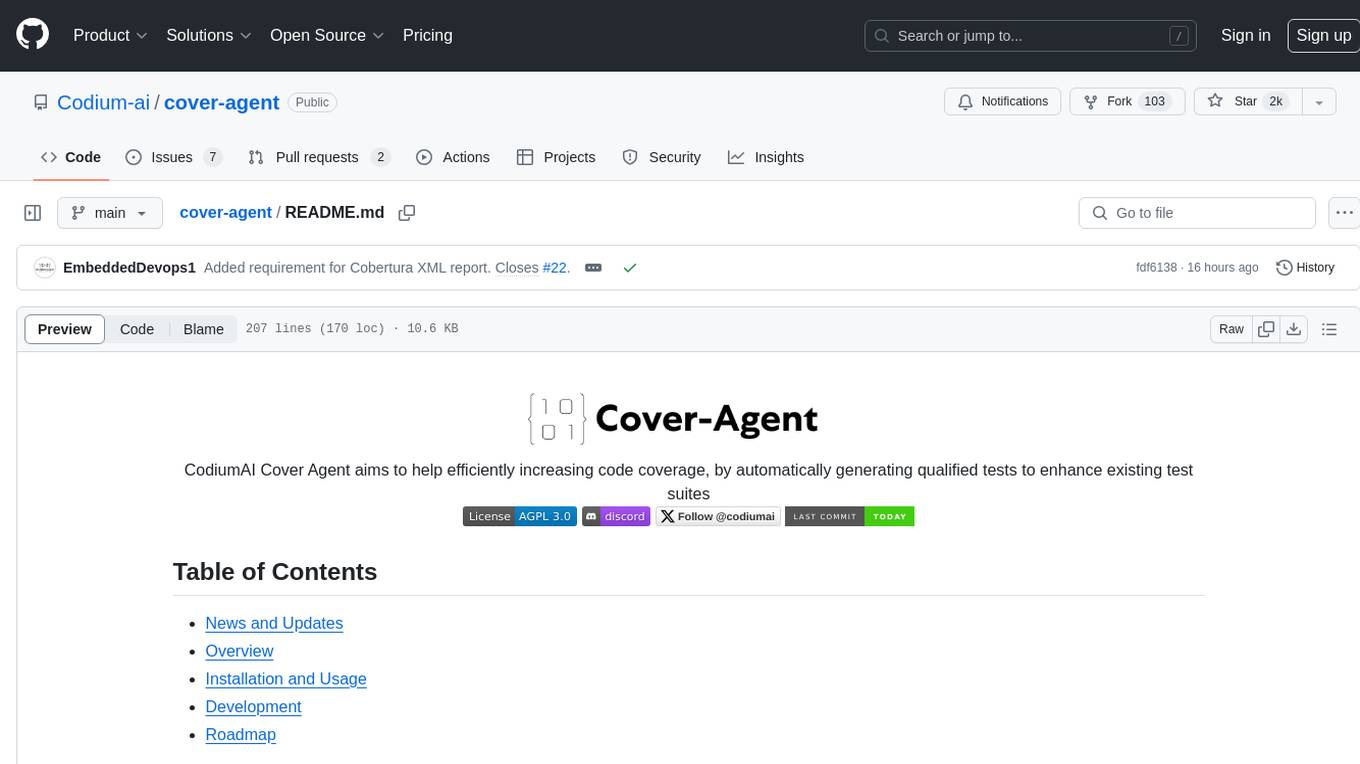
CodiumAI Cover Agent is a tool designed to help increase code coverage by automatically generating qualified tests to enhance existing test suites. It utilizes Generative AI to streamline development workflows and is part of a suite of utilities aimed at automating the creation of unit tests for software projects. The system includes components like Test Runner, Coverage Parser, Prompt Builder, and AI Caller to simplify and expedite the testing process, ensuring high-quality software development. Cover Agent can be run via a terminal and is planned to be integrated into popular CI platforms. The tool outputs debug files locally, such as generated_prompt.md, run.log, and test_results.html, providing detailed information on generated tests and their status. It supports multiple LLMs and allows users to specify the model to use for test generation.
README:
The logic and prompts for adding new imports for the generated tests have been improved.
We also added a usage examples file, with more elaborate examples of how to use the Cover Agent.
Added support for comprehensive logging to Weights and Biases. Set the WANDB_API_KEY environment variable to enable this feature.
Cover-Agent now supports nearly any LLM model in the world, using LiteLLM package.
Notice that GPT-4 outperforms almost any open-source model in the world when it comes to code tasks and following complicated instructions.
However, we updated the post-processing scripts to be more comprehensive, and were able to successfully run the baseline script with llama3-8B and llama3-70B models, for example.
This repository includes the first known implementation of TestGen-LLM, described in the paper Automated Unit Test Improvement using Large Language Models at Meta.
Welcome to Cover-Agent. This focused project utilizes Generative AI to automate and enhance the generation of tests (currently mostly unit tests), aiming to streamline development workflows. Cover-Agent can run via a terminal, and is planned to be integrated into popular CI platforms.
We invite the community to collaborate and help extend the capabilities of Cover Agent, continuing its development as a cutting-edge solution in the automated unit test generation domain. We also wish to inspire researchers to leverage this open-source tool to explore new test-generation techniques.
This tool is part of a broader suite of utilities designed to automate the creation of unit tests for software projects. Utilizing advanced Generative AI models, it aims to simplify and expedite the testing process, ensuring high-quality software development. The system comprises several components:
- Test Runner: Executes the command or scripts to run the test suite and generate code coverage reports.
- Coverage Parser: Validates that code coverage increases as tests are added, ensuring that new tests contribute to the overall test effectiveness.
- Prompt Builder: Gathers necessary data from the codebase and constructs the prompt to be passed to the Large Language Model (LLM).
- AI Caller: Interacts with the LLM to generate tests based on the prompt provided.
Before you begin, make sure you have the following:
-
OPENAI_API_KEYset in your environment variables, which is required for calling the OpenAI API. - Code Coverage tool: A Cobertura XML code coverage report is required for the tool to function correctly.
- For example, in Python one could use
pytest-cov. Add the--cov-report=xmloption when running Pytest. - Note: We are actively working on adding more coverage types but please feel free to open a PR and contribute to
cover_agent/CoverageProcessor.py
- For example, in Python one could use
If running directly from the repository you will also need:
- Python installed on your system.
- Poetry installed for managing Python package dependencies. Installation instructions for Poetry can be found at https://python-poetry.org/docs/.
The Cover Agent can be installed as a Python Pip package or run as a standalone executable.
To install the Python Pip package directly via GitHub run the following command:
pip install git+https://github.com/Codium-ai/cover-agent.git
The binary can be run without any Python environment installed on your system (e.g. within a Docker container that does not contain Python). You can download the release for your system by navigating to the project's release page.
Run the following command to install all the dependencies and run the project from source:
poetry installAfter downloading the executable or installing the Pip package you can run the Cover Agent to generate and validate unit tests. Execute it from the command line by using the following command:
cover-agent \
--source-file-path "<path_to_source_file>" \
--test-file-path "<path_to_test_file>" \
--code-coverage-report-path "<path_to_coverage_report>" \
--test-command "<test_command_to_run>" \
--test-command-dir "<directory_to_run_test_command>" \
--coverage-type "<type_of_coverage_report>" \
--desired-coverage <desired_coverage_between_0_and_100> \
--max-iterations <max_number_of_llm_iterations> \
--included-files "<optional_list_of_files_to_include>"You can use the example code below to try out the Cover Agent. (Note that the usage_examples file provides more elaborate examples of how to use the Cover Agent)
Follow the steps in the README.md file located in the templated_tests/python_fastapi/ directory to setup an environment, then return to the root of the repository, and run the following command to add tests to the python fastapi example:
cover-agent \
--source-file-path "templated_tests/python_fastapi/app.py" \
--test-file-path "templated_tests/python_fastapi/test_app.py" \
--code-coverage-report-path "templated_tests/python_fastapi/coverage.xml" \
--test-command "pytest --cov=. --cov-report=xml --cov-report=term" \
--test-command-dir "templated_tests/python_fastapi" \
--coverage-type "cobertura" \
--desired-coverage 70 \
--max-iterations 10For an example using go cd into templated_tests/go_webservice, set up the project following the README.md.
To work with coverage reporting, you need to install gocov and gocov-xml. Run the following commands to install these tools:
go install github.com/axw/gocov/[email protected]
go install github.com/AlekSi/[email protected]and then run the following command:
cover-agent \
--source-file-path "app.go" \
--test-file-path "app_test.go" \
--code-coverage-report-path "coverage.xml" \
--test-command "go test -coverprofile=coverage.out && gocov convert coverage.out | gocov-xml > coverage.xml" \
--test-command-dir $(pwd) \
--coverage-type "cobertura" \
--desired-coverage 70 \
--max-iterations 1For an example using java cd into templated_tests/java_gradle, set up the project following the README.md.
To work with jacoco coverage reporting, follow the README.md Requirements section:
and then run the following command:
cover-agent \
--source-file-path="src/main/java/com/davidparry/cover/SimpleMathOperations.java" \
--test-file-path="src/test/groovy/com/davidparry/cover/SimpleMathOperationsSpec.groovy" \
--code-coverage-report-path="build/reports/jacoco/test/jacocoTestReport.csv" \
--test-command="./gradlew clean test jacocoTestReport" \
--test-command-dir=$(pwd) \
--coverage-type="jacoco" \
--desired-coverage=70 \
--max-iterations=1A few debug files will be outputted locally within the repository (that are part of the .gitignore)
-
run.log: A copy of the logger that gets dumped to yourstdout -
test_results.html: A results table that contains the following for each generated test:- Test status
- Failure reason (if applicable)
- Exit code,
stderrstdout- Generated test
If you set an environment variable WANDB_API_KEY, the prompts, responses, and additional information will be logged to Weights and Biases.
This project uses LiteLLM to communicate with OpenAI and other hosted LLMs (supporting 100+ LLMs to date). To use a different model other than the OpenAI default you'll need to:
- Export any environment variables needed by the supported LLM following the LiteLLM instructions.
- Call the name of the model using the
--modeloption when calling Cover Agent.
For example (as found in the LiteLLM Quick Start guide):
export VERTEX_PROJECT="hardy-project"
export VERTEX_LOCATION="us-west"
cover-agent \
...
--model "vertex_ai/gemini-pro"export OPENAI_API_KEY="<your api key>" # If <your-api-base> requires an API KEY, set this value.
cover-agent \
...
--model "openai/<your model name>" \
--api-base "<your-api-base>"This section discusses the development of this project.
Before merging to main make sure to manually increment the version number in cover_agent/version.txt at the root of the repository.
Set up your development environment by running the poetry install command as you did above.
Note: for older versions of Poetry you may need to include the --dev option to install Dev dependencies.
After setting up your environment run the following command:
poetry run pytest --junitxml=testLog.xml --cov=templated_tests --cov=cover_agent --cov-report=xml --cov-report=term --log-cli-level=INFO
This will also generate all logs and output reports that are generated in .github/workflows/ci_pipeline.yml.
You can build the binary locally simply by invoking the make installer command. This will run PyInstaller locally on your machine. Ensure that you have set up the poetry project first (i.e. running poetry install).
Below is the roadmap of planned features, with the current implementation status:
- [x] Automatically generates unit tests for your software projects, utilizing advanced AI models to ensure comprehensive test coverage and quality assurance. (similar to Meta)
- [x] Being able to generate tests for different programming languages
- [ ] Being able to deal with a large variety of testing scenarios
- [ ] Generate a behavior analysis for the code under test, and generate tests accordingly
- [x] Check test flakiness, e.g. by running 5 times as suggested by TestGen-LLM
- [ ] Cover more test generation pains
- [ ] Generate new tests that are focused on the PR changeset
- [ ] Run over an entire repo/code-base and attempt to enhance all existing test suites
- [ ] Improve usability
- [ ] Connectors for GitHub Actions, Jenkins, CircleCI, Travis CI, and more
- [ ] Integrate into databases, APIs, OpenTelemetry and other sources of data to extract relevant i/o for the test generation
- [ ] Add a setting file
CodiumAI's mission is to enable busy dev teams to increase and maintain their code integrity. We offer various tools, including "Pro" versions of our open-source tools, which are meant to handle enterprise-level code complexity and are multi-repo codebase aware.
For Tasks:
Click tags to check more tools for each tasksFor Jobs:
Alternative AI tools for cover-agent
Similar Open Source Tools

cover-agent
CodiumAI Cover Agent is a tool designed to help increase code coverage by automatically generating qualified tests to enhance existing test suites. It utilizes Generative AI to streamline development workflows and is part of a suite of utilities aimed at automating the creation of unit tests for software projects. The system includes components like Test Runner, Coverage Parser, Prompt Builder, and AI Caller to simplify and expedite the testing process, ensuring high-quality software development. Cover Agent can be run via a terminal and is planned to be integrated into popular CI platforms. The tool outputs debug files locally, such as generated_prompt.md, run.log, and test_results.html, providing detailed information on generated tests and their status. It supports multiple LLMs and allows users to specify the model to use for test generation.
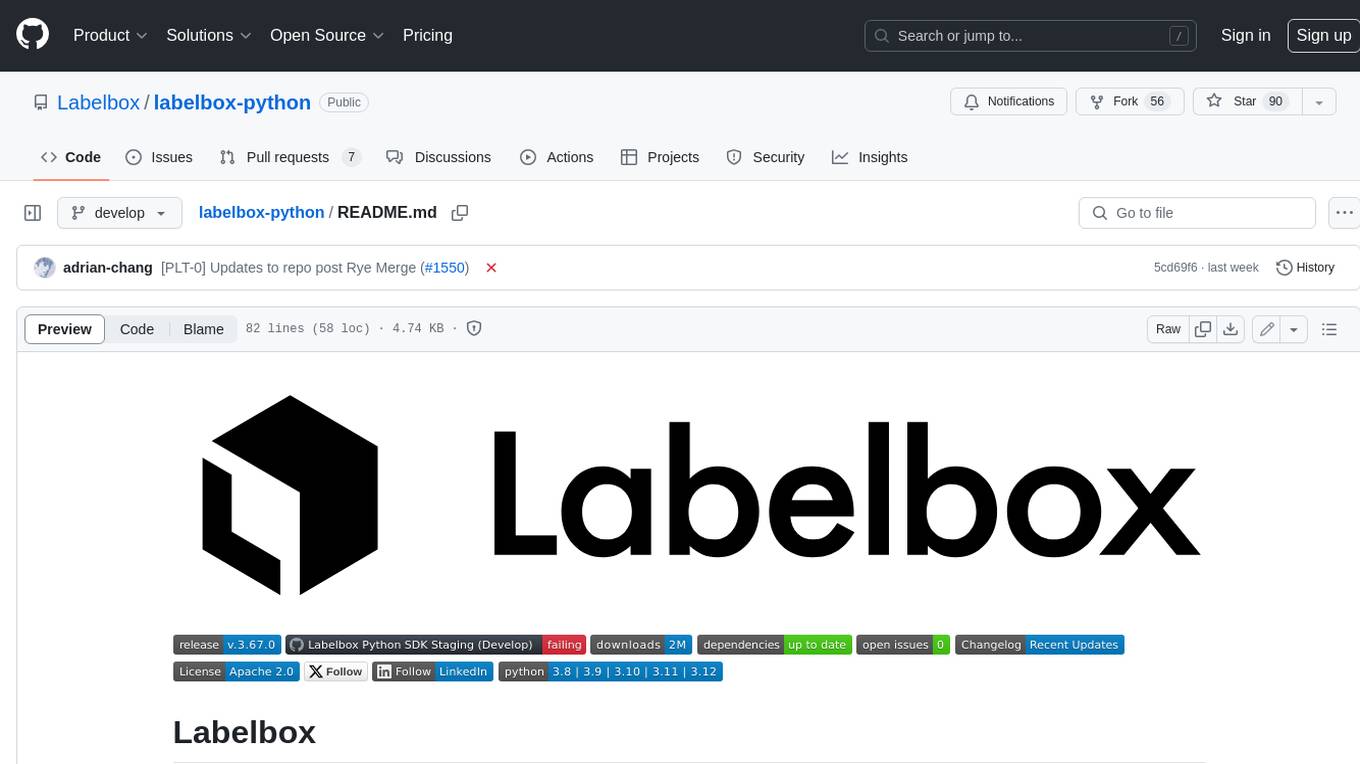
labelbox-python
Labelbox is a data-centric AI platform for enterprises to develop, optimize, and use AI to solve problems and power new products and services. Enterprises use Labelbox to curate data, generate high-quality human feedback data for computer vision and LLMs, evaluate model performance, and automate tasks by combining AI and human-centric workflows. The academic & research community uses Labelbox for cutting-edge AI research.
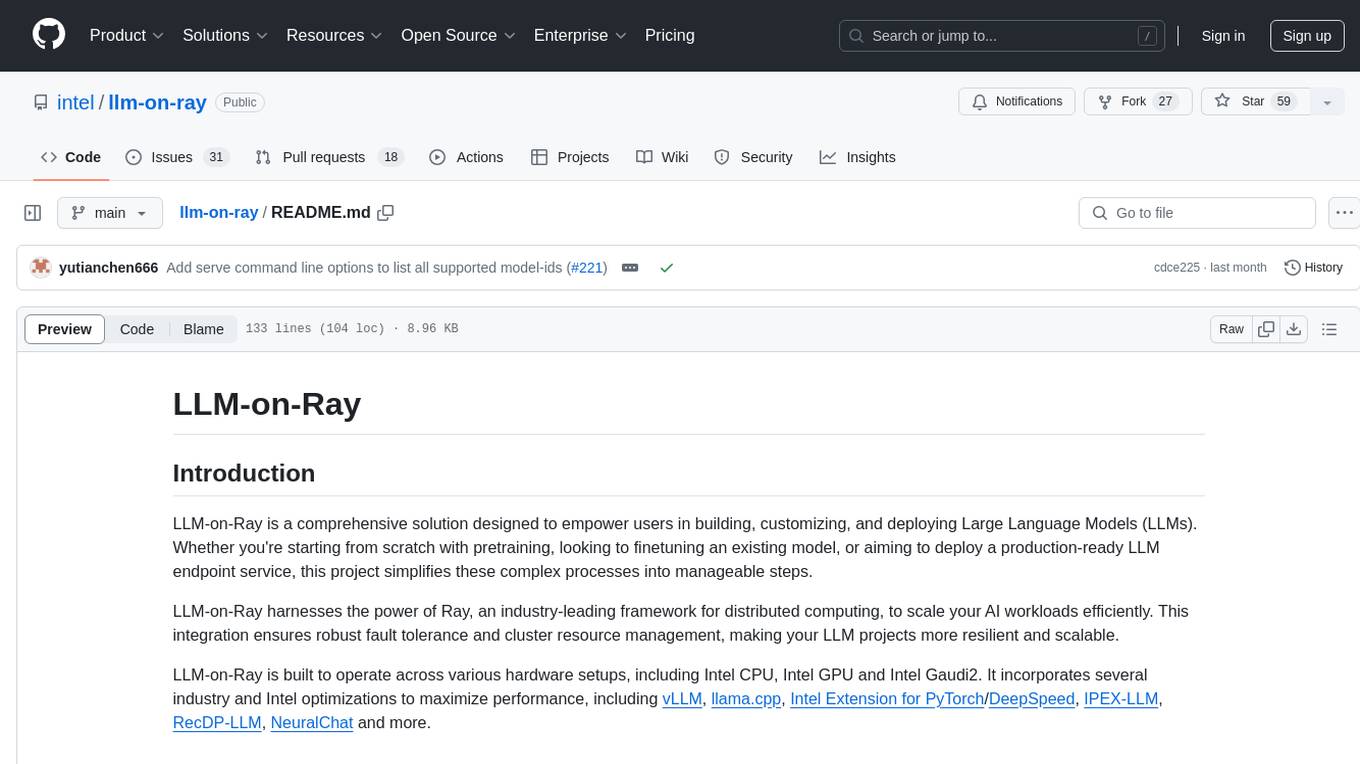
llm-on-ray
LLM-on-Ray is a comprehensive solution for building, customizing, and deploying Large Language Models (LLMs). It simplifies complex processes into manageable steps by leveraging the power of Ray for distributed computing. The tool supports pretraining, finetuning, and serving LLMs across various hardware setups, incorporating industry and Intel optimizations for performance. It offers modular workflows with intuitive configurations, robust fault tolerance, and scalability. Additionally, it provides an Interactive Web UI for enhanced usability, including a chatbot application for testing and refining models.
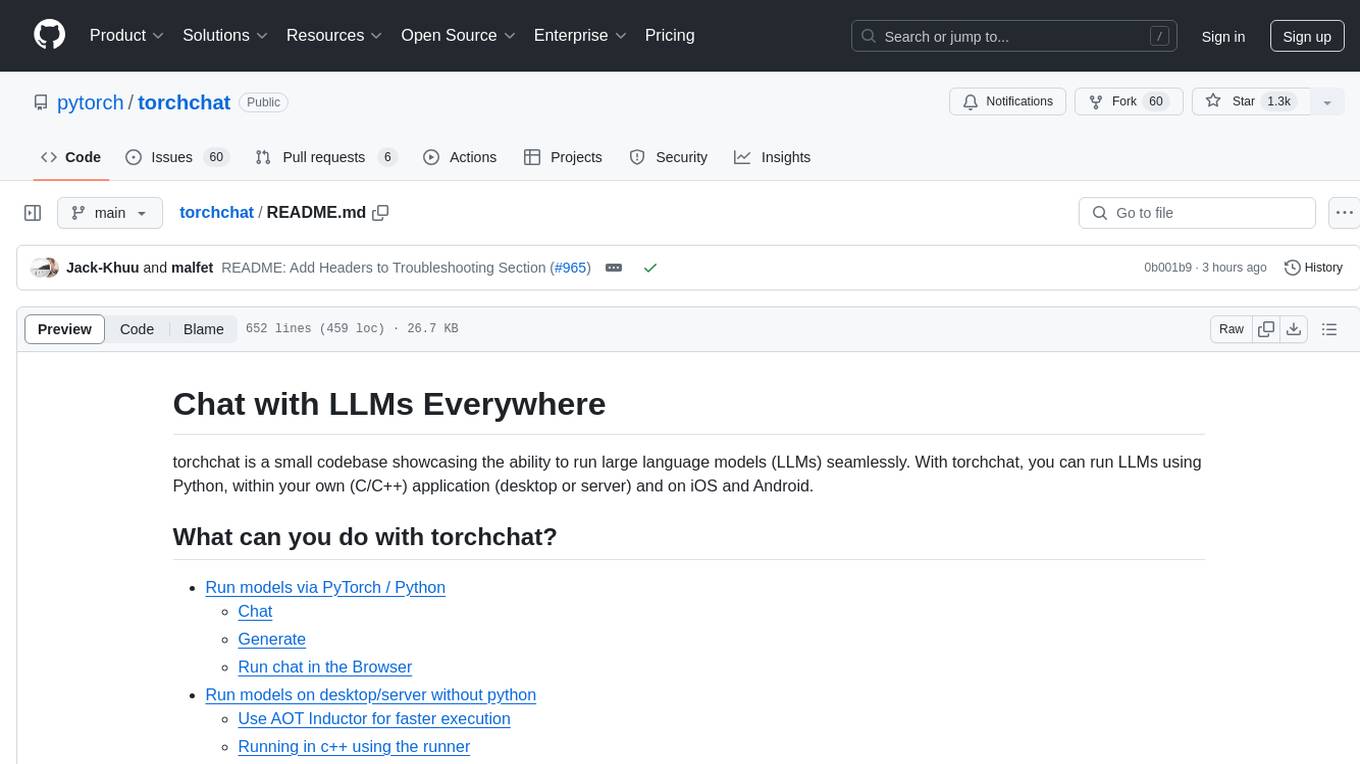
torchchat
torchchat is a codebase showcasing the ability to run large language models (LLMs) seamlessly. It allows running LLMs using Python in various environments such as desktop, server, iOS, and Android. The tool supports running models via PyTorch, chatting, generating text, running chat in the browser, and running models on desktop/server without Python. It also provides features like AOT Inductor for faster execution, running in C++ using the runner, and deploying and running on iOS and Android. The tool supports popular hardware and OS including Linux, Mac OS, Android, and iOS, with various data types and execution modes available.
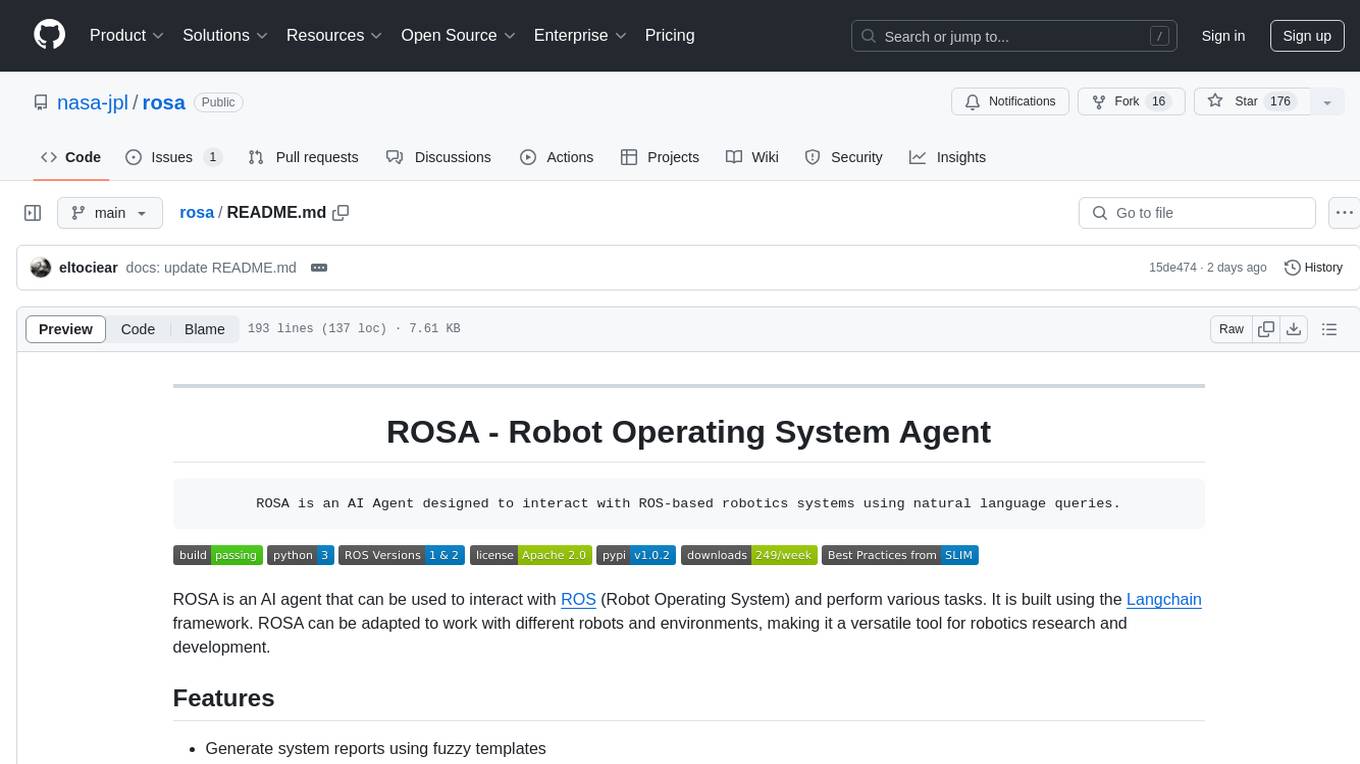
rosa
ROSA is an AI Agent designed to interact with ROS-based robotics systems using natural language queries. It can generate system reports, read and parse ROS log files, adapt to new robots, and run various ROS commands using natural language. The tool is versatile for robotics research and development, providing an easy way to interact with robots and the ROS environment.
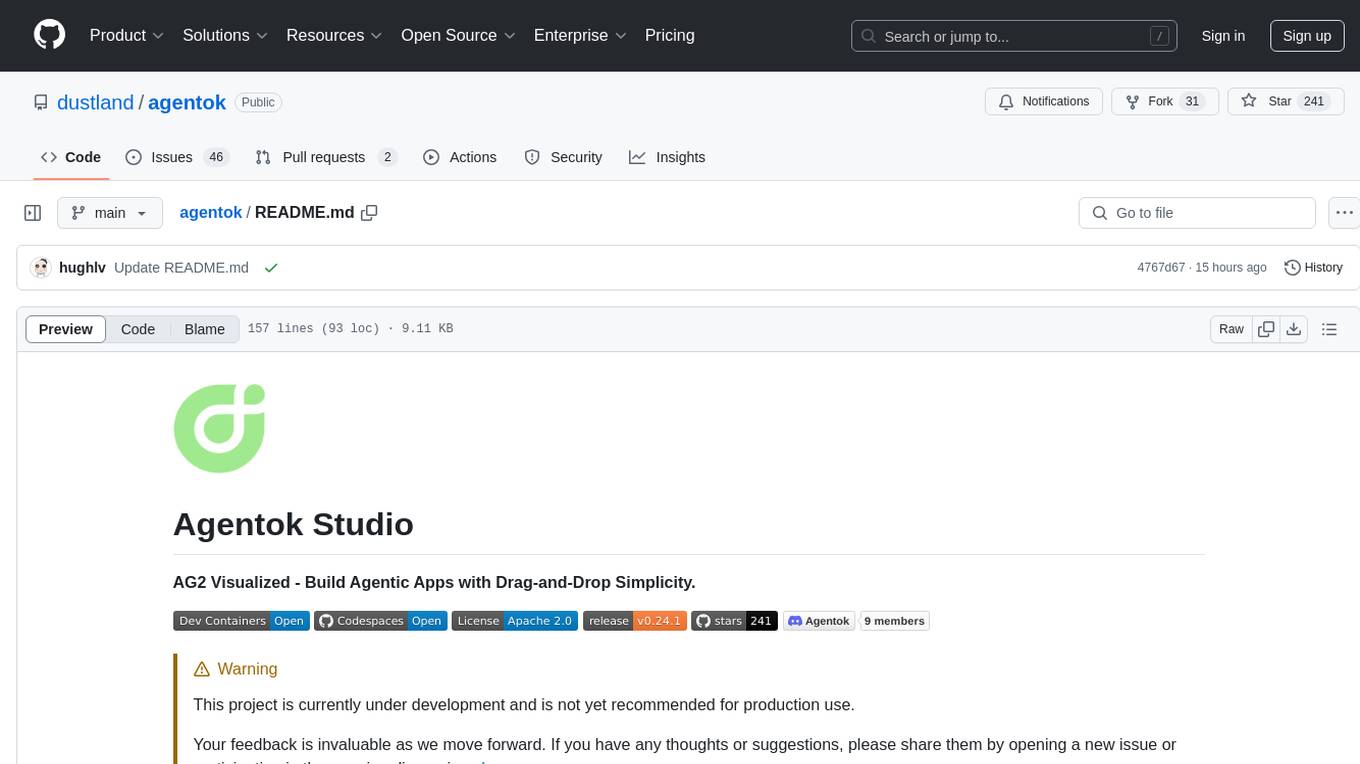
agentok
Agentok Studio is a tool built upon AG2, a powerful agent framework from Microsoft, offering intuitive visual tools to streamline the creation and management of complex agent-based workflows. It simplifies the process for creators and developers by generating native Python code with minimal dependencies, enabling users to create self-contained code that can be executed anywhere. The tool is currently under development and not recommended for production use, but contributions are welcome from the community to enhance its capabilities and functionalities.
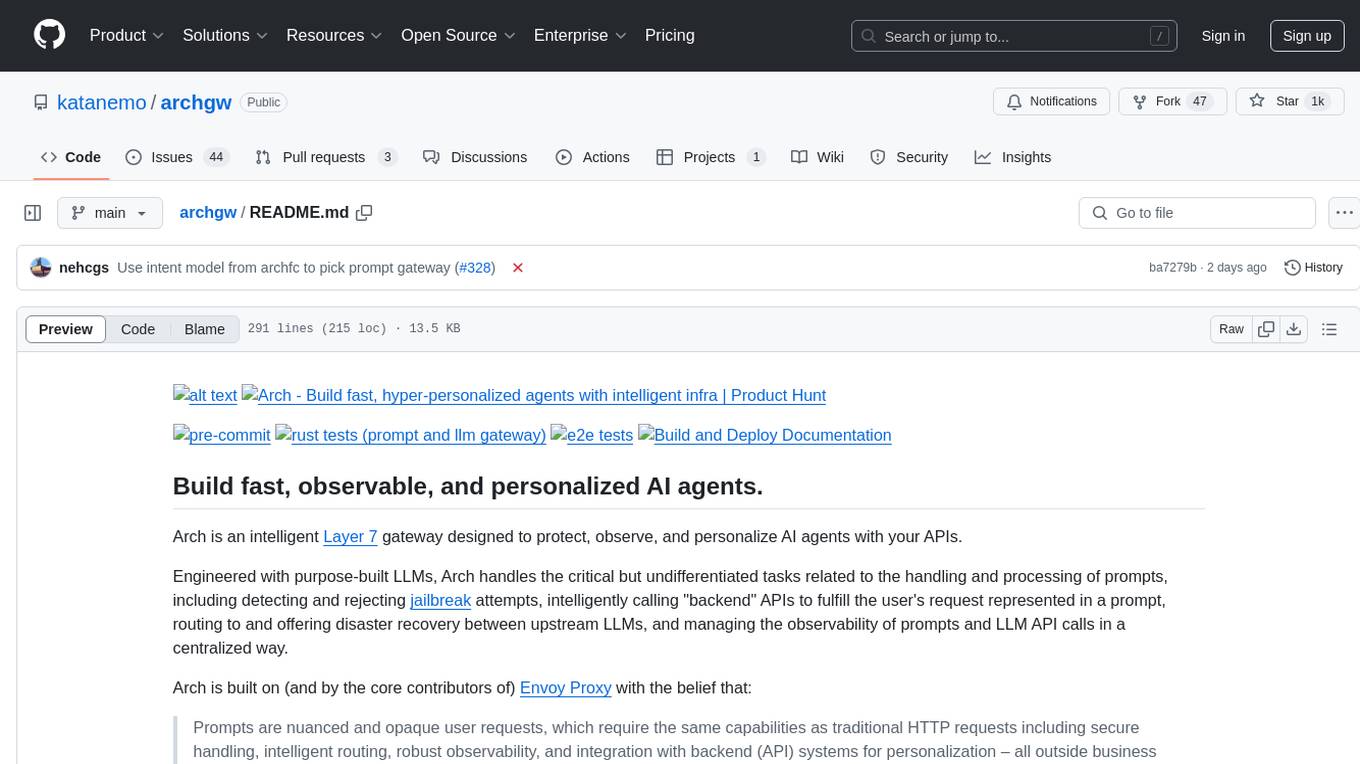
archgw
Arch is an intelligent Layer 7 gateway designed to protect, observe, and personalize AI agents with APIs. It handles tasks related to prompts, including detecting jailbreak attempts, calling backend APIs, routing between LLMs, and managing observability. Built on Envoy Proxy, it offers features like function calling, prompt guardrails, traffic management, and observability. Users can build fast, observable, and personalized AI agents using Arch to improve speed, security, and personalization of GenAI apps.
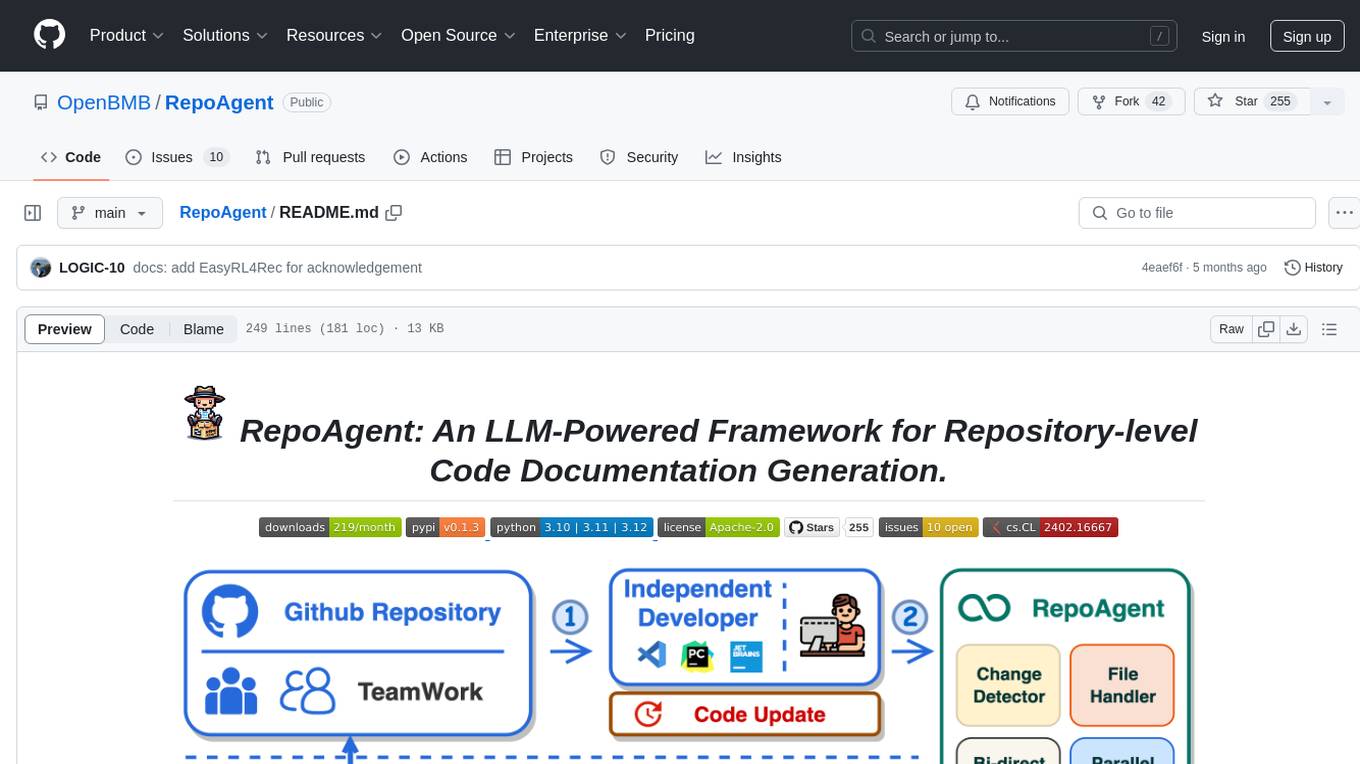
RepoAgent
RepoAgent is an LLM-powered framework designed for repository-level code documentation generation. It automates the process of detecting changes in Git repositories, analyzing code structure through AST, identifying inter-object relationships, replacing Markdown content, and executing multi-threaded operations. The tool aims to assist developers in understanding and maintaining codebases by providing comprehensive documentation, ultimately improving efficiency and saving time.
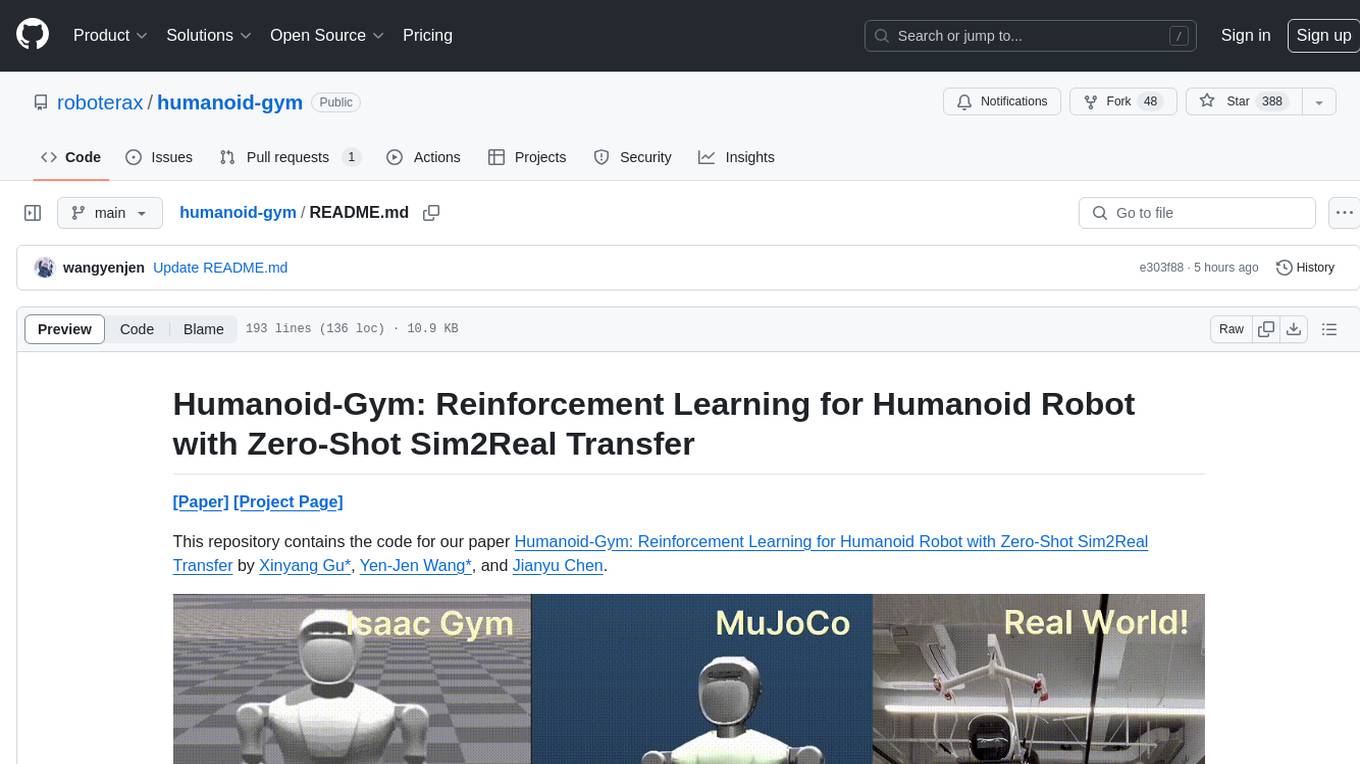
humanoid-gym
Humanoid-Gym is a reinforcement learning framework designed for training locomotion skills for humanoid robots, focusing on zero-shot transfer from simulation to real-world environments. It integrates a sim-to-sim framework from Isaac Gym to Mujoco for verifying trained policies in different physical simulations. The codebase is verified with RobotEra's XBot-S and XBot-L humanoid robots. It offers comprehensive training guidelines, step-by-step configuration instructions, and execution scripts for easy deployment. The sim2sim support allows transferring trained policies to accurate simulated environments. The upcoming features include Denoising World Model Learning and Dexterous Hand Manipulation. Installation and usage guides are provided along with examples for training PPO policies and sim-to-sim transformations. The code structure includes environment and configuration files, with instructions on adding new environments. Troubleshooting tips are provided for common issues, along with a citation and acknowledgment section.
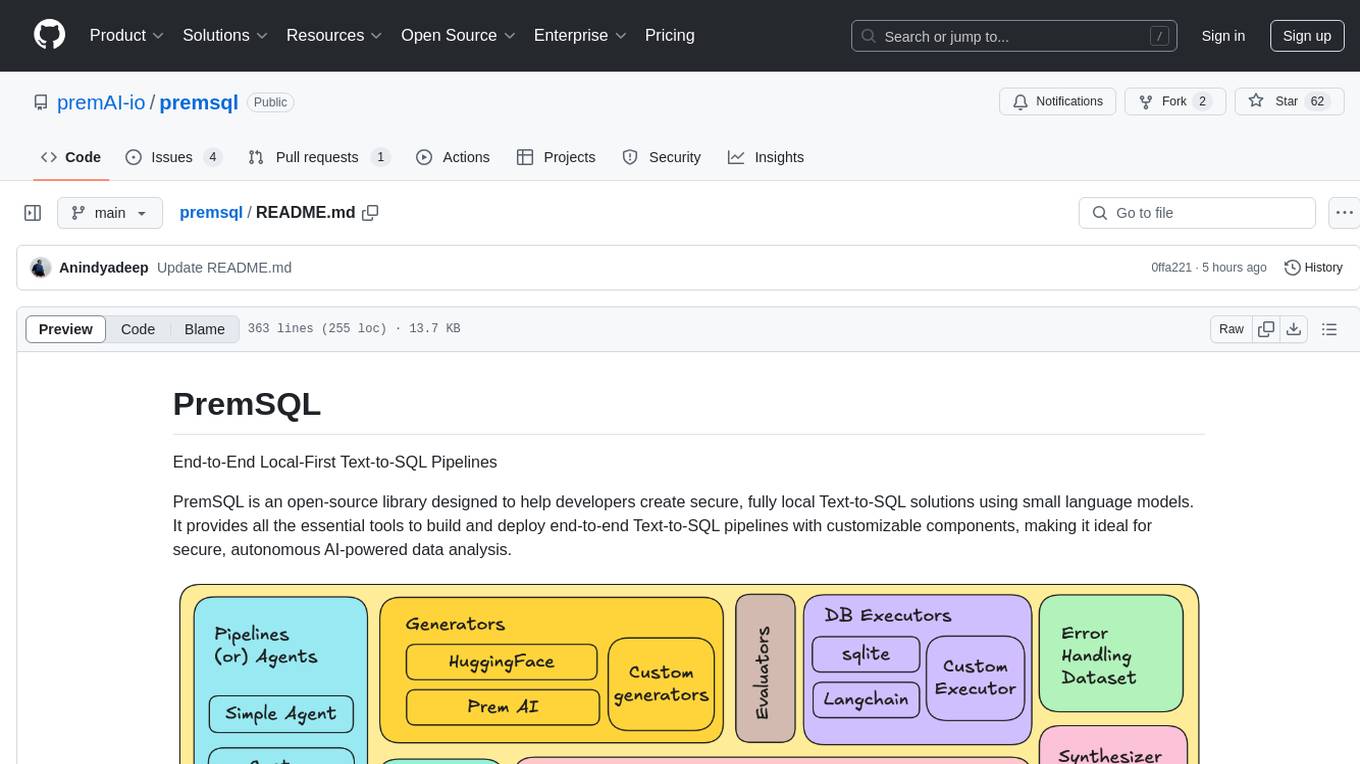
premsql
PremSQL is an open-source library designed to help developers create secure, fully local Text-to-SQL solutions using small language models. It provides essential tools for building and deploying end-to-end Text-to-SQL pipelines with customizable components, ideal for secure, autonomous AI-powered data analysis. The library offers features like Local-First approach, Customizable Datasets, Robust Executors and Evaluators, Advanced Generators, Error Handling and Self-Correction, Fine-Tuning Support, and End-to-End Pipelines. Users can fine-tune models, generate SQL queries from natural language inputs, handle errors, and evaluate model performance against predefined metrics. PremSQL is extendible for customization and private data usage.
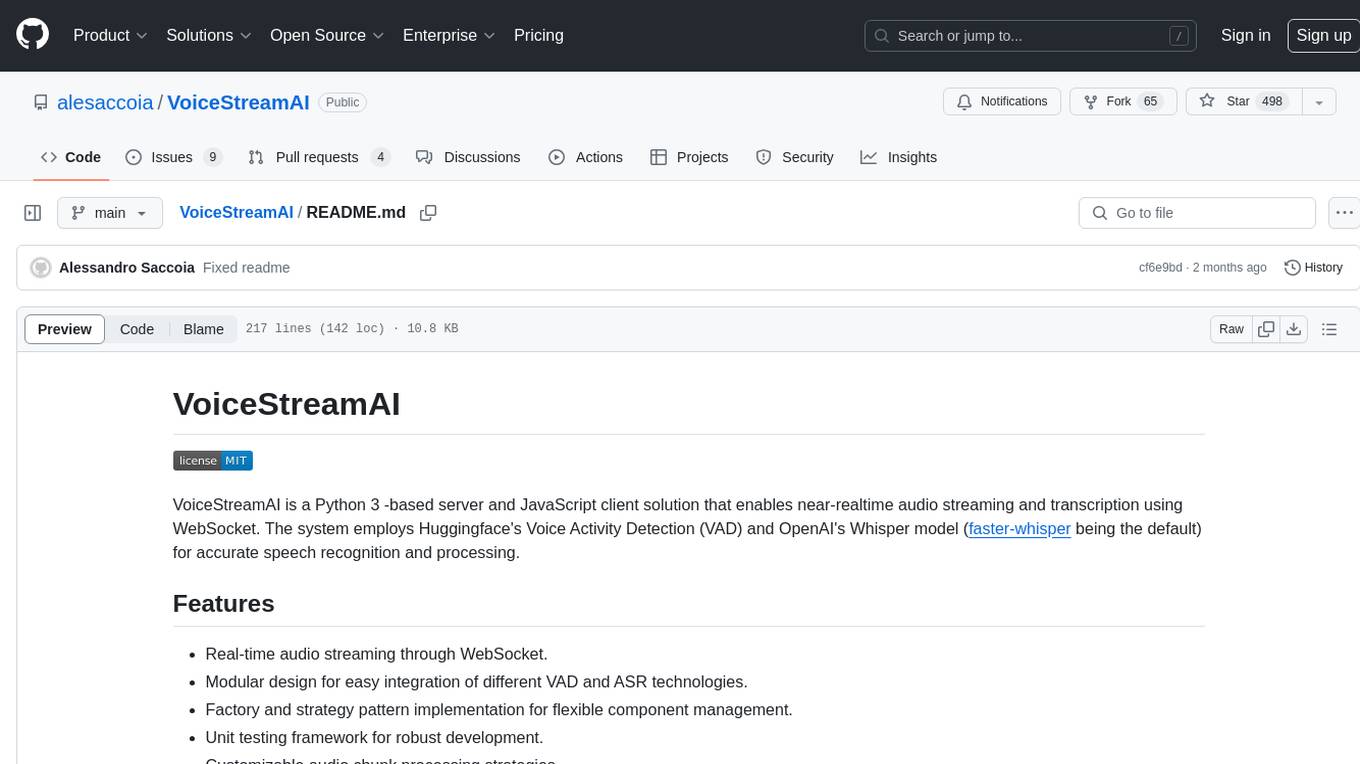
VoiceStreamAI
VoiceStreamAI is a Python 3-based server and JavaScript client solution for near-realtime audio streaming and transcription using WebSocket. It employs Huggingface's Voice Activity Detection (VAD) and OpenAI's Whisper model for accurate speech recognition. The system features real-time audio streaming, modular design for easy integration of VAD and ASR technologies, customizable audio chunk processing strategies, support for multilingual transcription, and secure sockets support. It uses a factory and strategy pattern implementation for flexible component management and provides a unit testing framework for robust development.
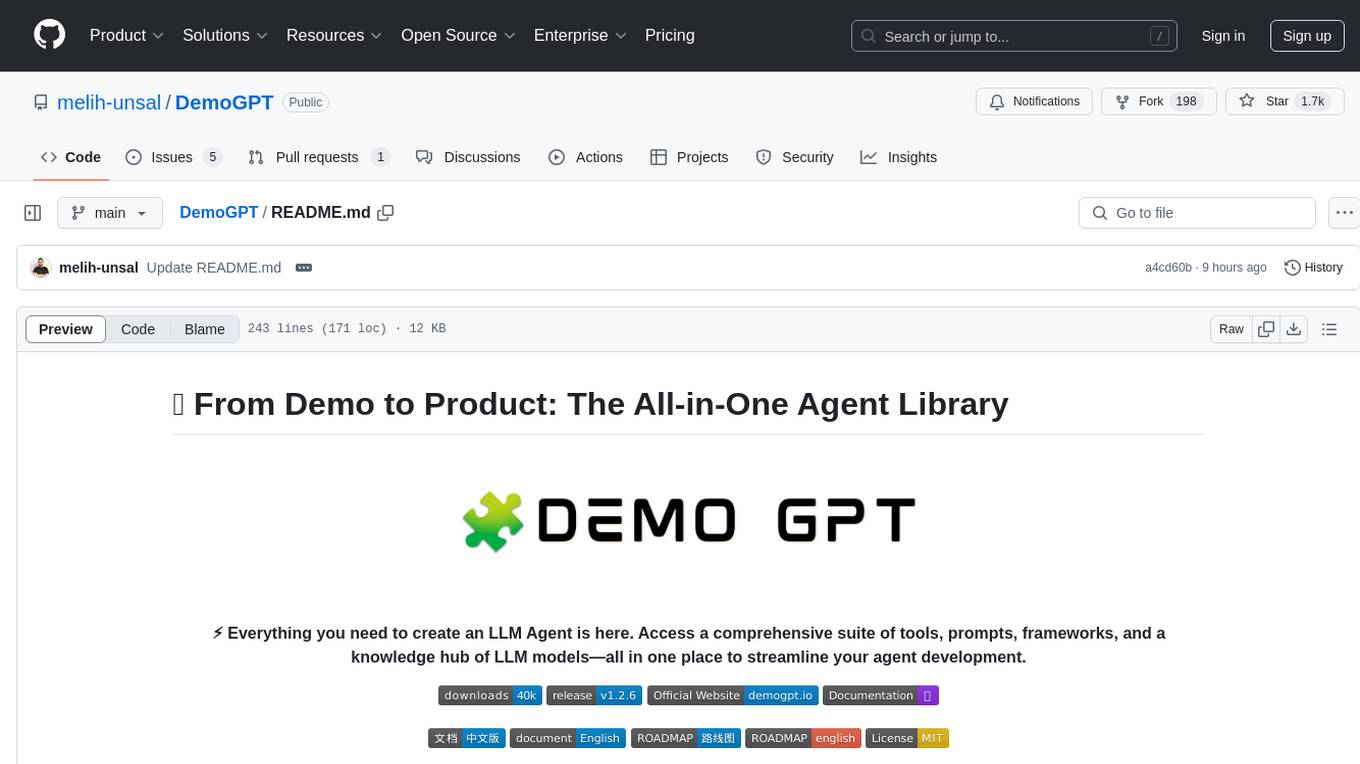
DemoGPT
DemoGPT is an all-in-one agent library that provides tools, prompts, frameworks, and LLM models for streamlined agent development. It leverages GPT-3.5-turbo to generate LangChain code, creating interactive Streamlit applications. The tool is designed for creating intelligent, interactive, and inclusive solutions in LLM-based application development. It offers model flexibility, iterative development, and a commitment to user engagement. Future enhancements include integrating Gorilla for autonomous API usage and adding a publicly available database for refining the generation process.
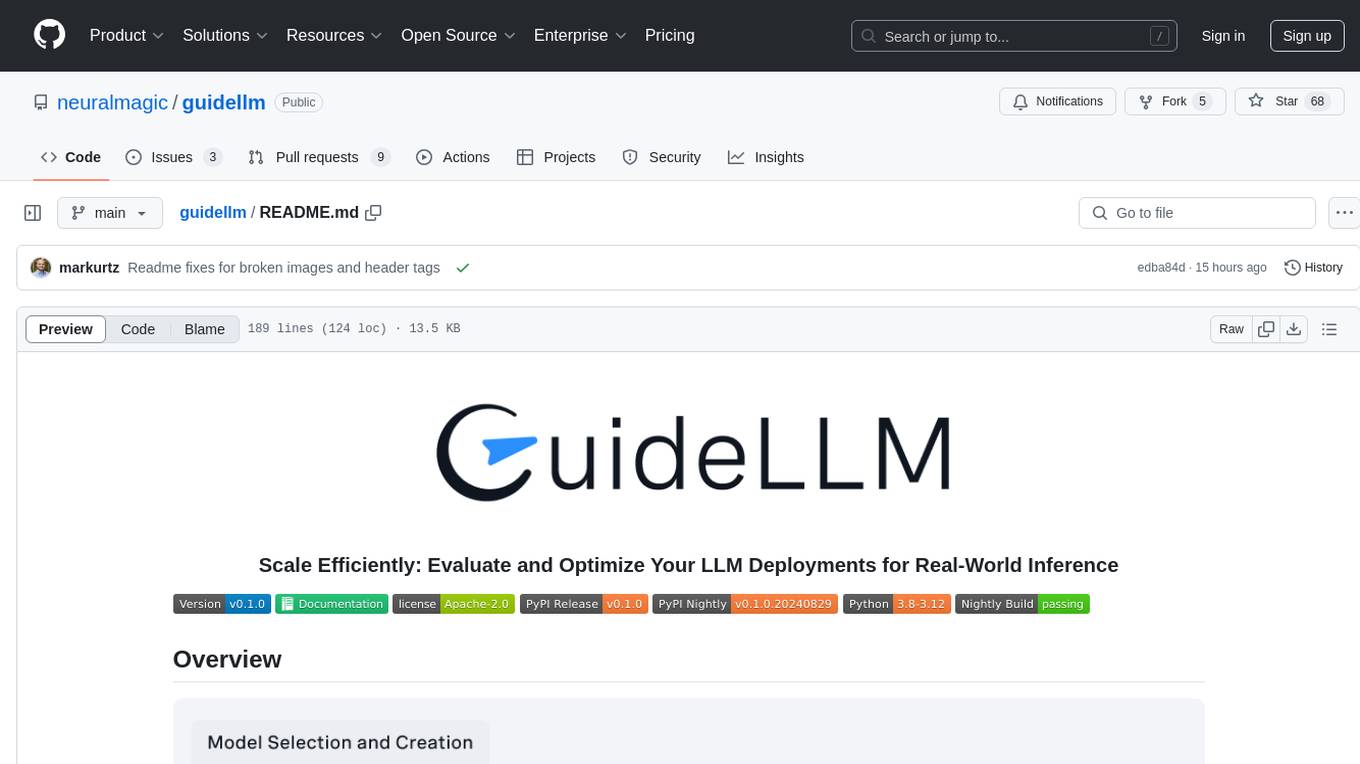
guidellm
GuideLLM is a powerful tool for evaluating and optimizing the deployment of large language models (LLMs). By simulating real-world inference workloads, GuideLLM helps users gauge the performance, resource needs, and cost implications of deploying LLMs on various hardware configurations. This approach ensures efficient, scalable, and cost-effective LLM inference serving while maintaining high service quality. Key features include performance evaluation, resource optimization, cost estimation, and scalability testing.
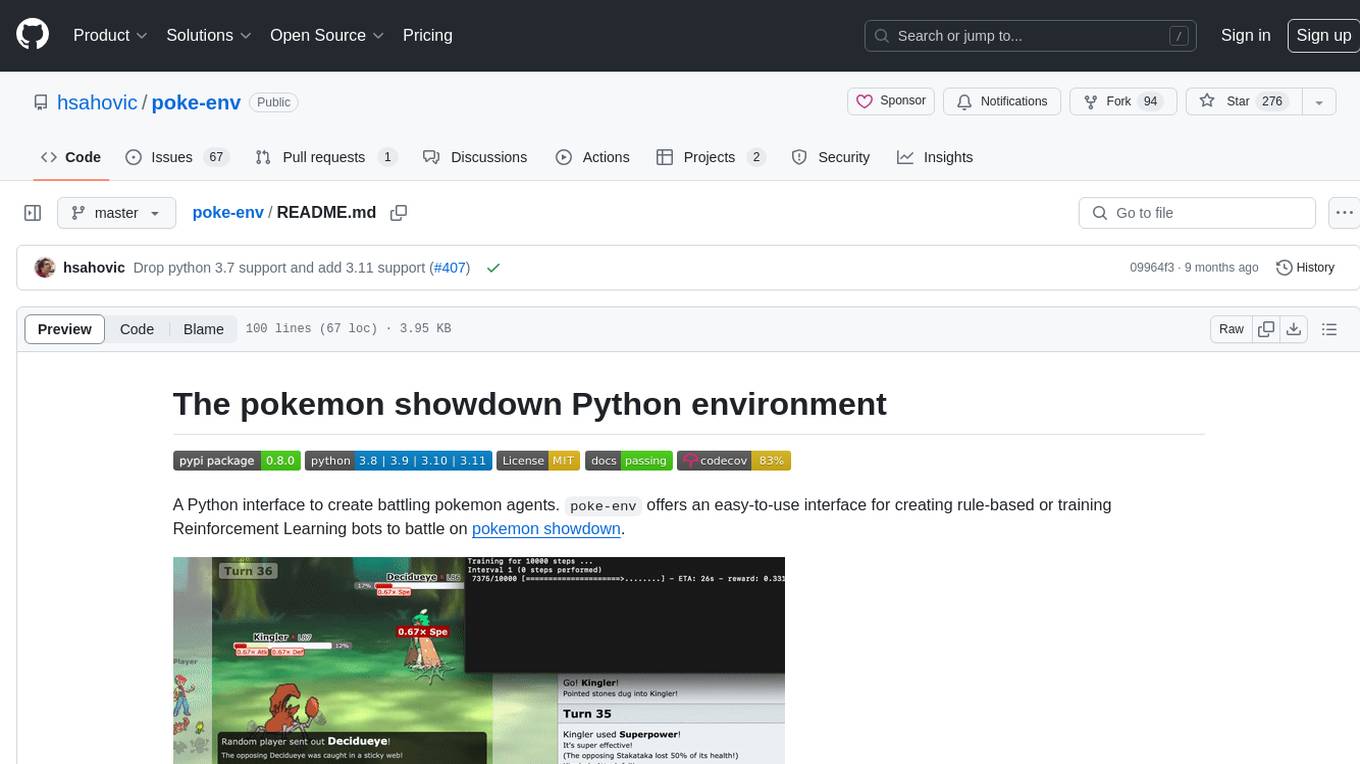
poke-env
A Python interface for creating battling Pokemon agents, 'poke-env' allows users to develop rule-based or Reinforcement Learning bots to battle on Pokemon Showdown. The tool provides an easy-to-use interface for agent creation and offers documentation, examples, and starting code for beginners. Users can install 'poke-env' via pip and set up a development server for testing. The project is inspired by an artificial intelligence class project and relies on data from Smogon forums' RMT section. It is licensed under MIT and can be cited using a provided BibTeX entry.
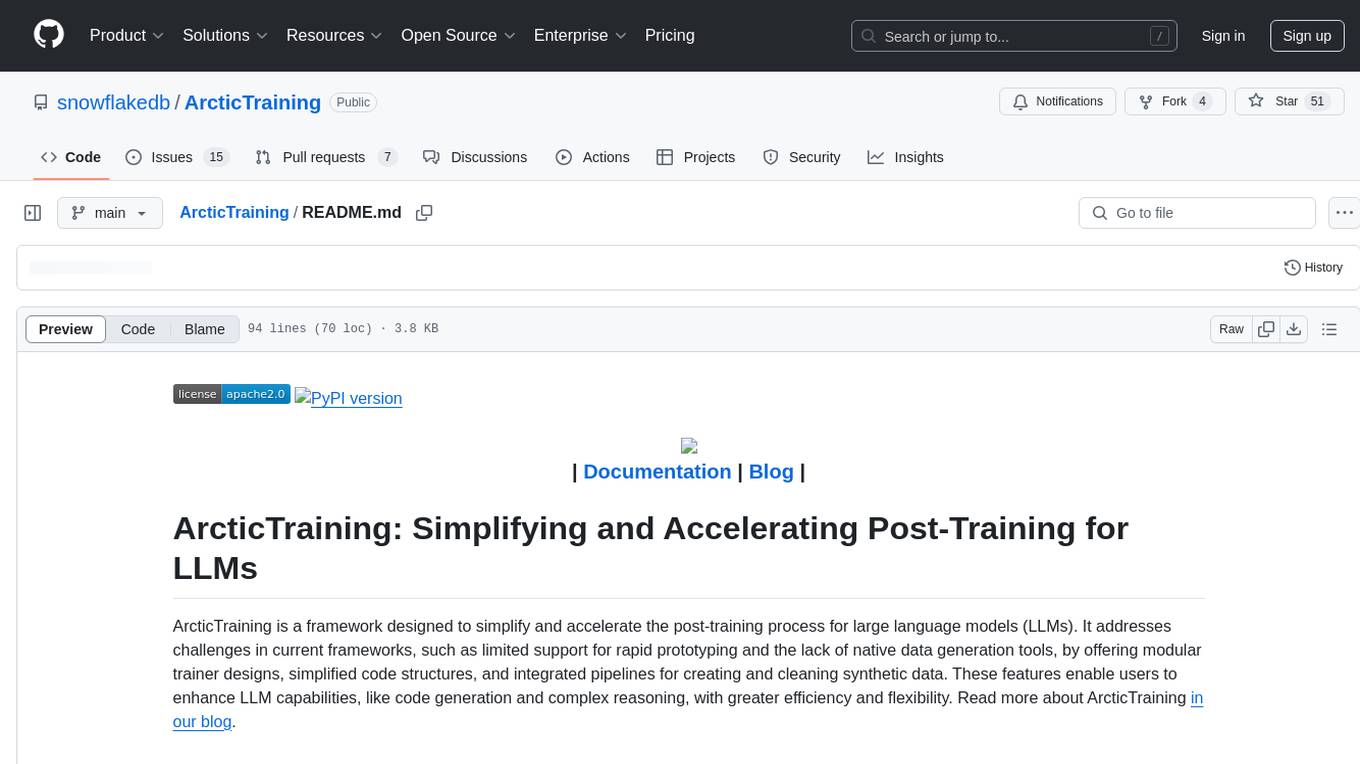
ArcticTraining
ArcticTraining is a framework designed to simplify and accelerate the post-training process for large language models (LLMs). It offers modular trainer designs, simplified code structures, and integrated pipelines for creating and cleaning synthetic data, enabling users to enhance LLM capabilities like code generation and complex reasoning with greater efficiency and flexibility.
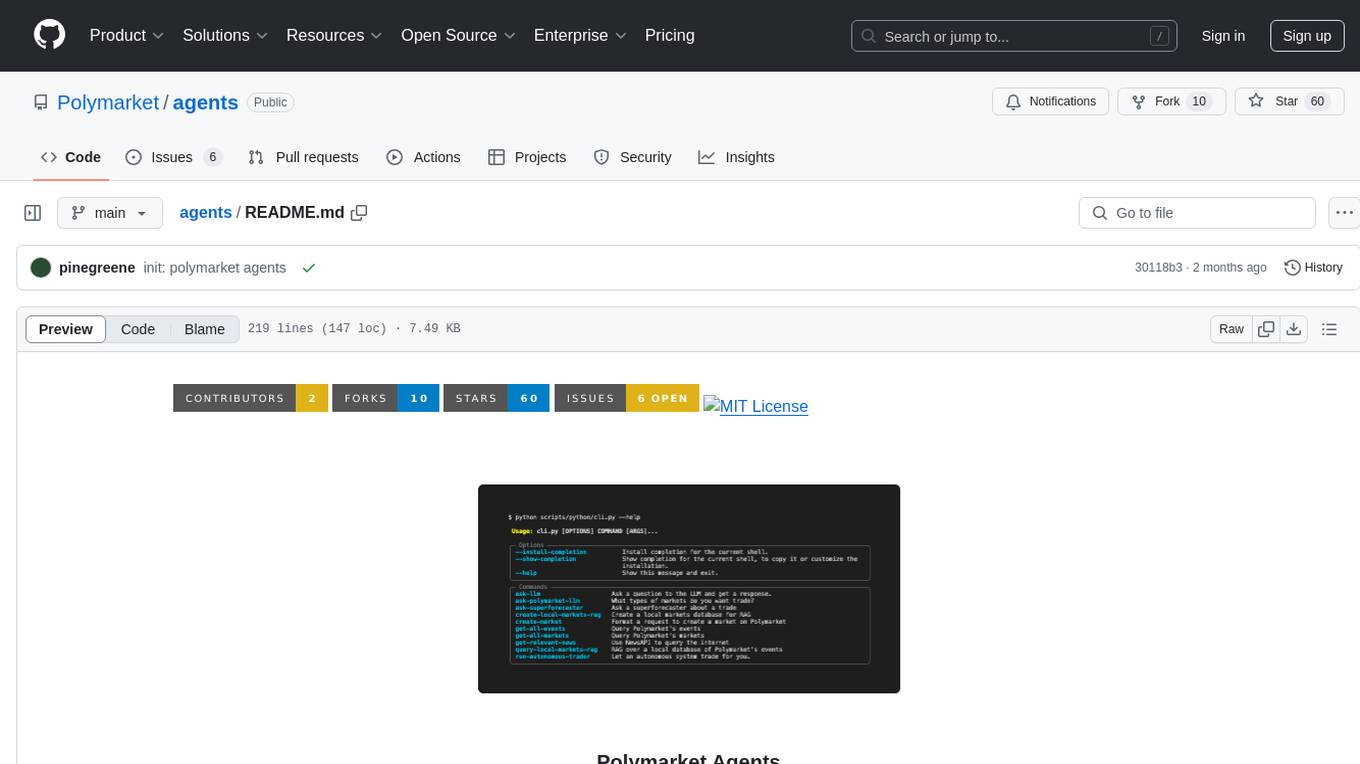
agents
Polymarket Agents is a developer framework and set of utilities for building AI agents to trade autonomously on Polymarket. It integrates with Polymarket API, provides AI agent utilities for prediction markets, supports local and remote RAG, sources data from various services, and offers comprehensive LLM tools for prompt engineering. The architecture features modular components like APIs and scripts for managing local environments, server set-up, and CLI for end-user commands.
For similar tasks

cover-agent
CodiumAI Cover Agent is a tool designed to help increase code coverage by automatically generating qualified tests to enhance existing test suites. It utilizes Generative AI to streamline development workflows and is part of a suite of utilities aimed at automating the creation of unit tests for software projects. The system includes components like Test Runner, Coverage Parser, Prompt Builder, and AI Caller to simplify and expedite the testing process, ensuring high-quality software development. Cover Agent can be run via a terminal and is planned to be integrated into popular CI platforms. The tool outputs debug files locally, such as generated_prompt.md, run.log, and test_results.html, providing detailed information on generated tests and their status. It supports multiple LLMs and allows users to specify the model to use for test generation.
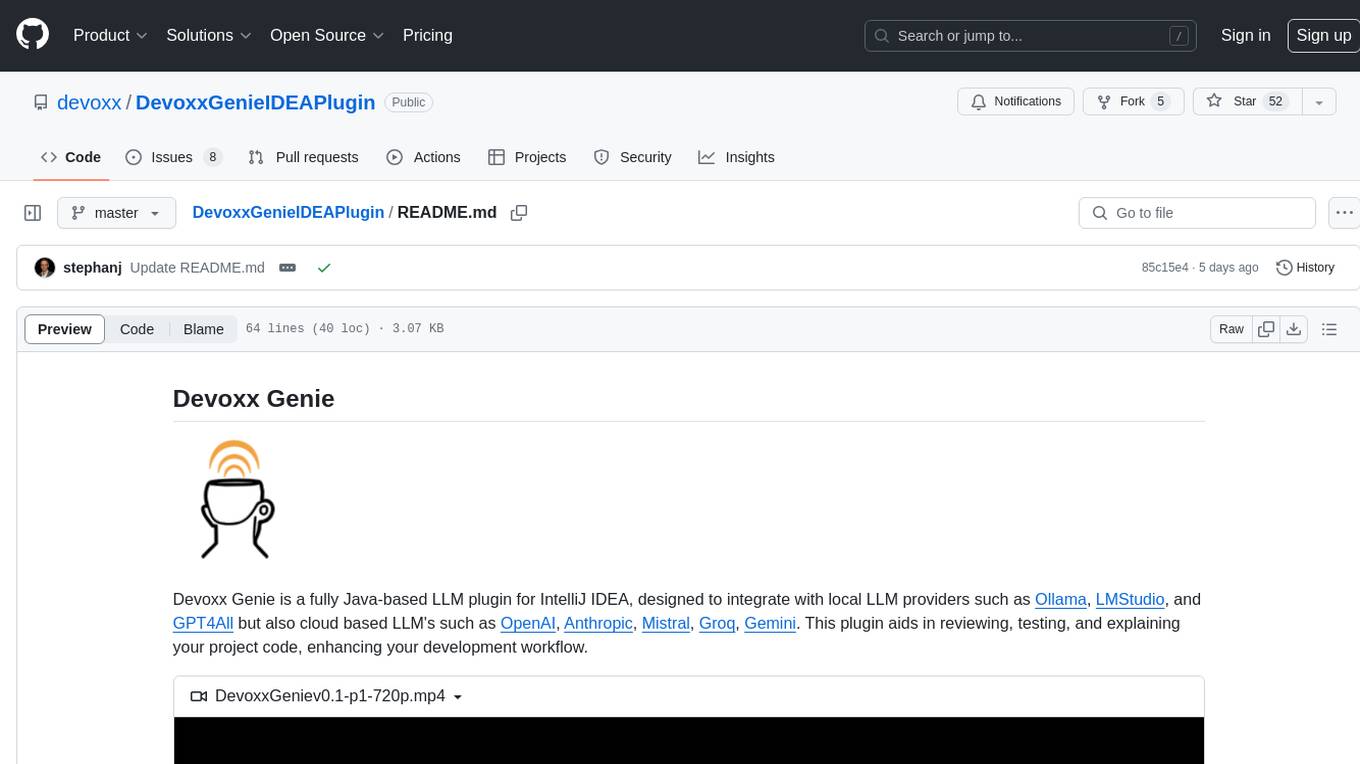
DevoxxGenieIDEAPlugin
Devoxx Genie is a Java-based IntelliJ IDEA plugin that integrates with local and cloud-based LLM providers to aid in reviewing, testing, and explaining project code. It supports features like code highlighting, chat conversations, and adding files/code snippets to context. Users can modify REST endpoints and LLM parameters in settings, including support for cloud-based LLMs. The plugin requires IntelliJ version 2023.3.4 and JDK 17. Building and publishing the plugin is done using Gradle tasks. Users can select an LLM provider, choose code, and use commands like review, explain, or generate unit tests for code analysis.
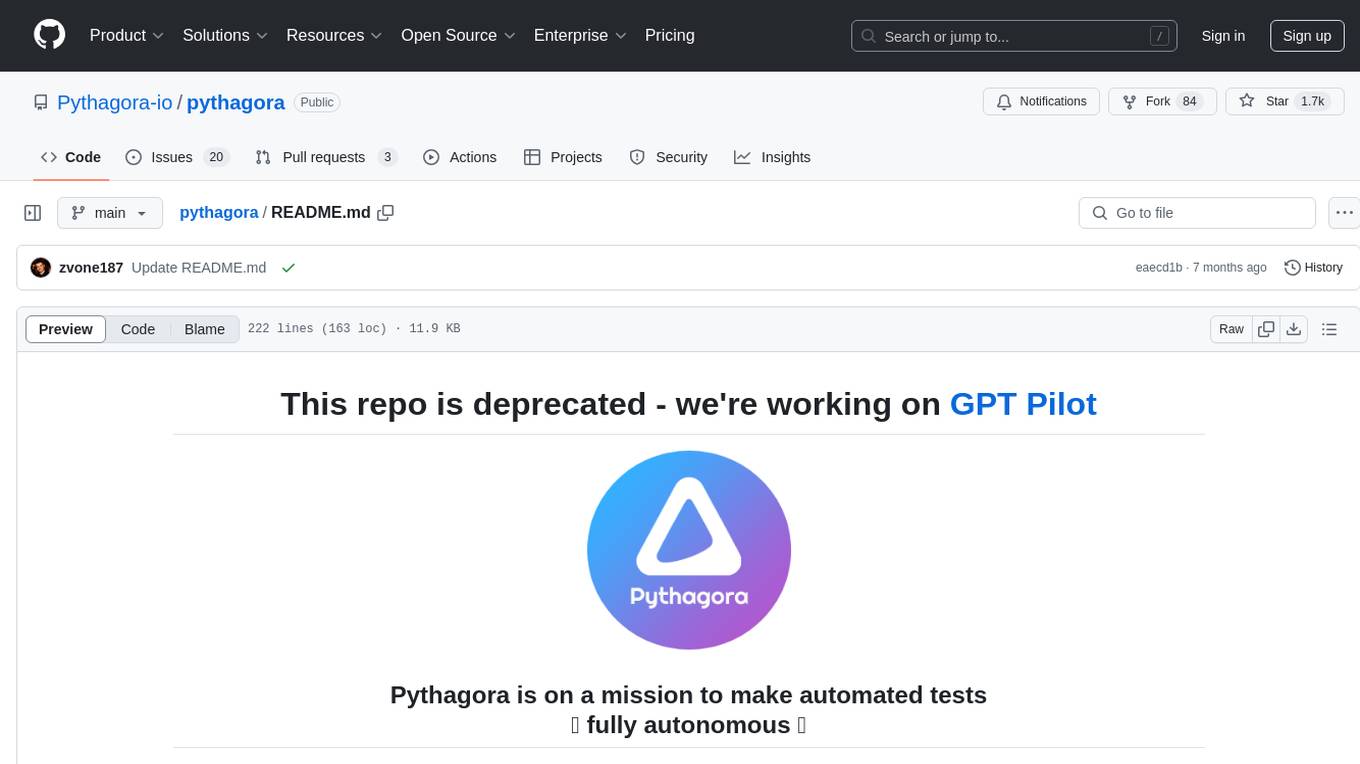
pythagora
Pythagora is an automated testing tool designed to generate unit tests using GPT-4. By running a single command, users can create tests for specific functions in their codebase. The tool leverages AST parsing to identify related functions and sends them to the Pythagora server for test generation. Pythagora primarily focuses on JavaScript code and supports Jest testing framework. Users can expand existing tests, increase code coverage, and find bugs efficiently. It is recommended to review the generated tests before committing them to the repository. Pythagora does not store user code on its servers but sends it to GPT and OpenAI for test generation.
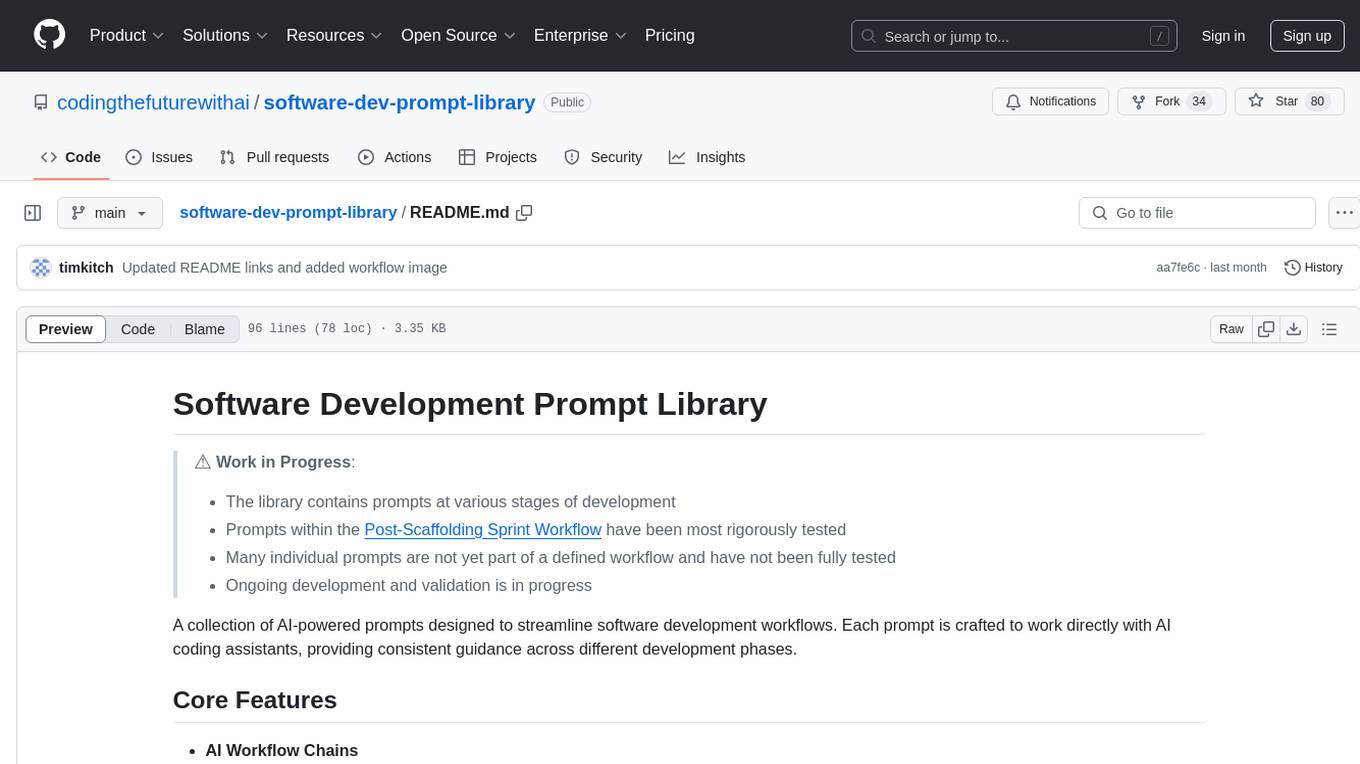
software-dev-prompt-library
A collection of AI-powered prompts designed to streamline software development workflows. The library contains prompts at various stages of development, with structured sequences of connected prompts, project initialization support, development assistance, and documentation generation. It aims to provide consistent guidance across different development phases, promote systematic development processes, and enable progress tracking and validation.

TestSpark
TestSpark is a plugin for generating unit tests that integrates AI-based test generation tools. It supports LLM-based test generation using OpenAI, HuggingFace, and JetBrains internal AI Assistant platform, as well as local search-based test generation using EvoSuite. Users can configure test generation settings, interact with test cases, view coverage statistics, and integrate tests into projects. The plugin is designed for experimental use to augment existing test suites, not replace manual test writing.
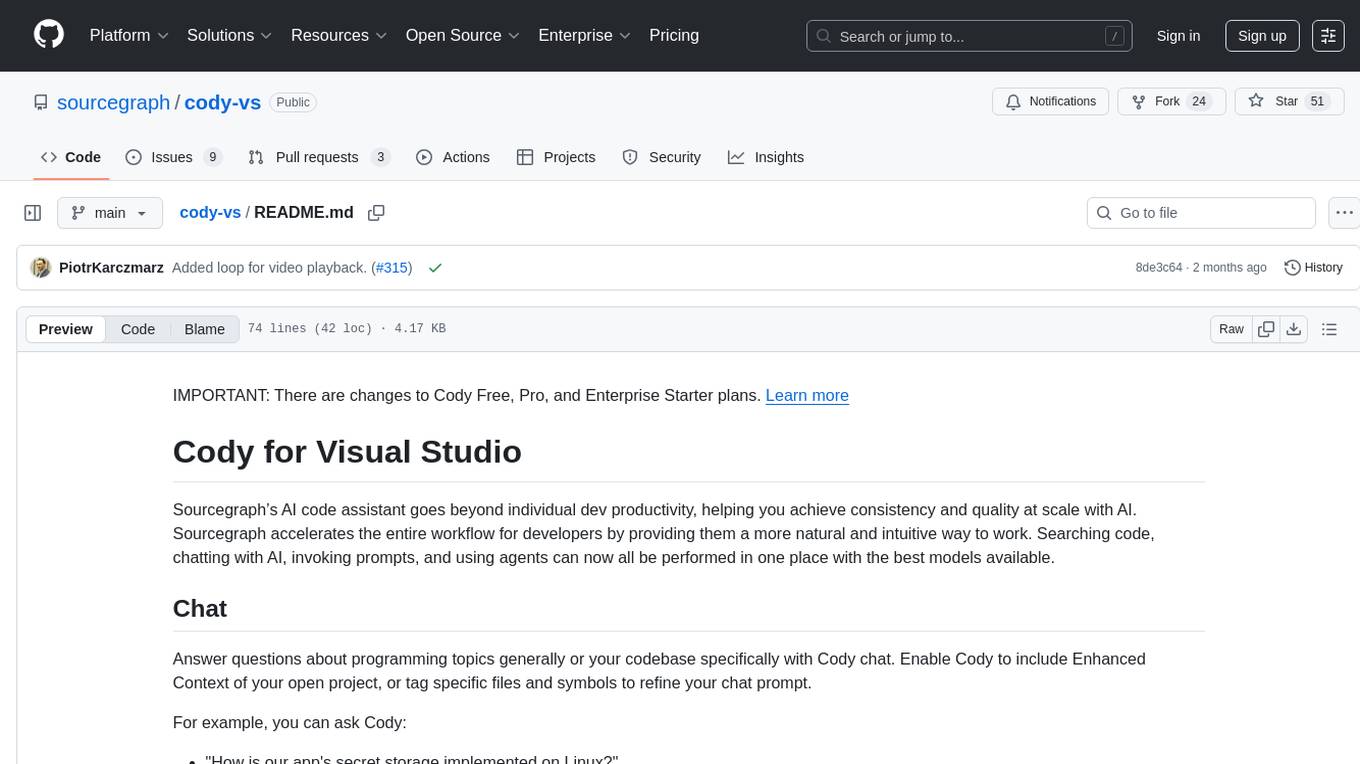
cody-vs
Sourcegraph’s AI code assistant, Cody for Visual Studio, enhances developer productivity by providing a natural and intuitive way to work. It offers features like chat, auto-edit, prompts, and works with various IDEs. Cody focuses on team productivity, offering whole codebase context and shared prompts for consistency. Users can choose from different LLM models like Claude, Gemini Pro, and OpenAI's GPT. Engineered for enterprise use, Cody supports flexible deployment and enterprise security. Suitable for any programming language, Cody excels with Python, Go, JavaScript, and TypeScript code.
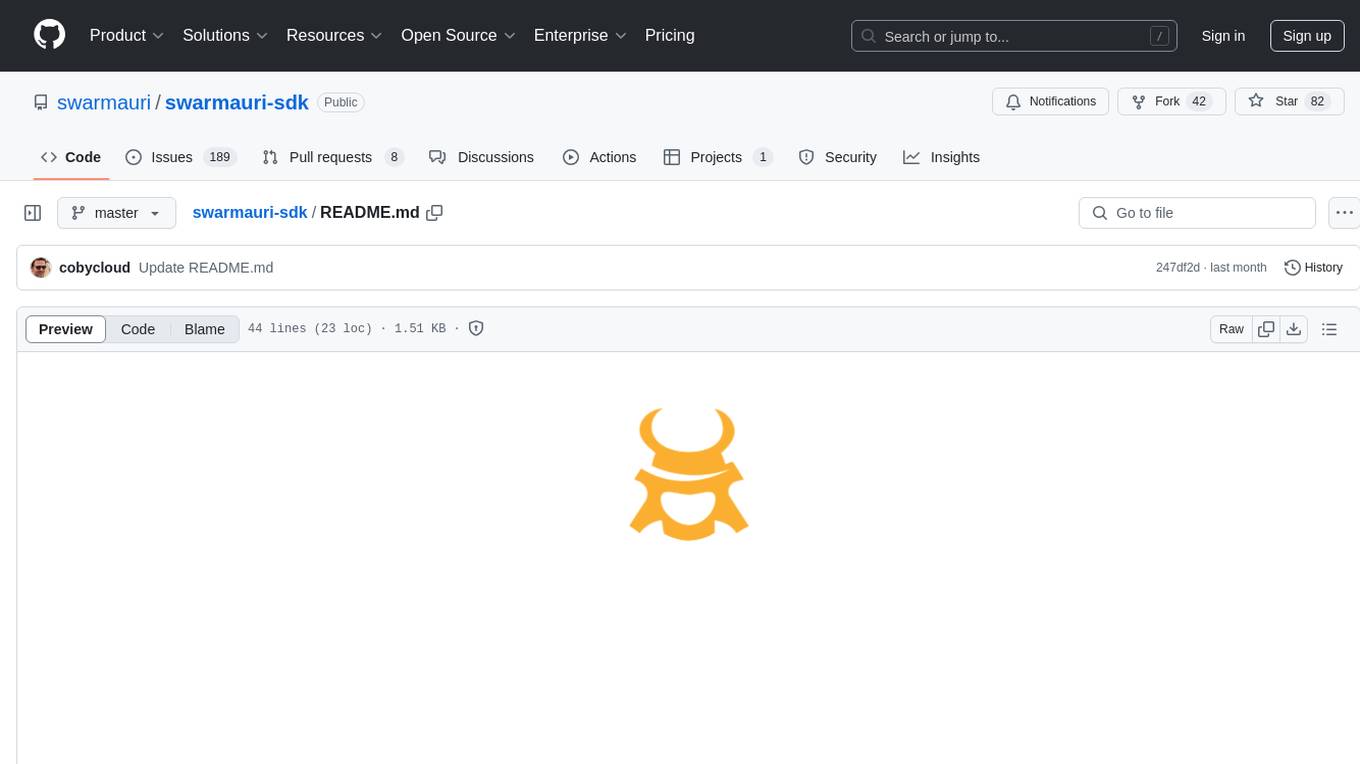
swarmauri-sdk
Swarmauri SDK is a repository containing core interfaces, standard ABCs, and standard concrete references of the SwarmaURI Framework. It provides a set of tools and functionalities for developers to work with the SwarmaURI ecosystem. The SDK aims to streamline the development process and enhance the interoperability of applications within the framework. Developers can easily integrate SwarmaURI features into their projects by leveraging the resources available in this repository.
For similar jobs

sweep
Sweep is an AI junior developer that turns bugs and feature requests into code changes. It automatically handles developer experience improvements like adding type hints and improving test coverage.

teams-ai
The Teams AI Library is a software development kit (SDK) that helps developers create bots that can interact with Teams and Microsoft 365 applications. It is built on top of the Bot Framework SDK and simplifies the process of developing bots that interact with Teams' artificial intelligence capabilities. The SDK is available for JavaScript/TypeScript, .NET, and Python.

ai-guide
This guide is dedicated to Large Language Models (LLMs) that you can run on your home computer. It assumes your PC is a lower-end, non-gaming setup.

classifai
Supercharge WordPress Content Workflows and Engagement with Artificial Intelligence. Tap into leading cloud-based services like OpenAI, Microsoft Azure AI, Google Gemini and IBM Watson to augment your WordPress-powered websites. Publish content faster while improving SEO performance and increasing audience engagement. ClassifAI integrates Artificial Intelligence and Machine Learning technologies to lighten your workload and eliminate tedious tasks, giving you more time to create original content that matters.

chatbot-ui
Chatbot UI is an open-source AI chat app that allows users to create and deploy their own AI chatbots. It is easy to use and can be customized to fit any need. Chatbot UI is perfect for businesses, developers, and anyone who wants to create a chatbot.

BricksLLM
BricksLLM is a cloud native AI gateway written in Go. Currently, it provides native support for OpenAI, Anthropic, Azure OpenAI and vLLM. BricksLLM aims to provide enterprise level infrastructure that can power any LLM production use cases. Here are some use cases for BricksLLM: * Set LLM usage limits for users on different pricing tiers * Track LLM usage on a per user and per organization basis * Block or redact requests containing PIIs * Improve LLM reliability with failovers, retries and caching * Distribute API keys with rate limits and cost limits for internal development/production use cases * Distribute API keys with rate limits and cost limits for students

uAgents
uAgents is a Python library developed by Fetch.ai that allows for the creation of autonomous AI agents. These agents can perform various tasks on a schedule or take action on various events. uAgents are easy to create and manage, and they are connected to a fast-growing network of other uAgents. They are also secure, with cryptographically secured messages and wallets.

griptape
Griptape is a modular Python framework for building AI-powered applications that securely connect to your enterprise data and APIs. It offers developers the ability to maintain control and flexibility at every step. Griptape's core components include Structures (Agents, Pipelines, and Workflows), Tasks, Tools, Memory (Conversation Memory, Task Memory, and Meta Memory), Drivers (Prompt and Embedding Drivers, Vector Store Drivers, Image Generation Drivers, Image Query Drivers, SQL Drivers, Web Scraper Drivers, and Conversation Memory Drivers), Engines (Query Engines, Extraction Engines, Summary Engines, Image Generation Engines, and Image Query Engines), and additional components (Rulesets, Loaders, Artifacts, Chunkers, and Tokenizers). Griptape enables developers to create AI-powered applications with ease and efficiency.



